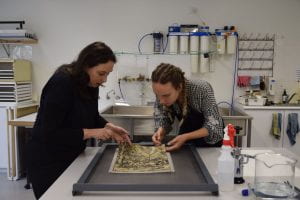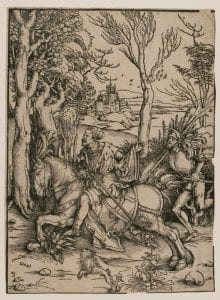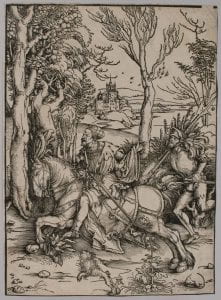Conserving Dürer’s woodcut “The Knight and the lansquenet”

The Poynton Collection forms part of the highly regarded Baillieu Library Print Collection, which over the years has invaluably contributed to the teaching of academic disciplines at the University of Melbourne (Anderson 2011, p. 5; Inglis 2011, p. 105). The collection is home to one of Albrecht Dürer’s enigmatic early woodcuts, The Knight and the lansquenet (c. 1496). This magnificent woodcut by the master printmaker depicts a knight on horseback and a lansquenet (foot soldier) in the woods. Unfortunately, a past attempt at repairing several prominent tears caused considerable aesthetic and physical damage. Consequently, the woodcut was deemed not suitable for exhibition without extensive conservation treatment.
A requirement of the Master of Cultural Materials Conservation at the Grimwade Centre, University of Melbourne is the completion of a minor thesis. Students are encouraged to choose a topic that best suits their interests and skills. With an undergraduate degree in conservation and several years of practical experience, my interests lie in the practical realm of paper conservation. As an emerging paper conservator, I have a keen interest in developing a greater knowledge in the fabrication and characteristics of materials through a variety of methods including literature research, enhanced visual examination and conservation treatment. When Dürer’s The Knight and the lansquenet woodcut was offered to me as a treatment-based thesis project I couldn’t believe my luck.
Over the past four months it has been a privilege examining and conducting research on The Knight and the lansquenet, gaining a deeper understanding of the woodcut’s provenance, history, significance, fabrication and condition. This assisted in the decision-making for conservation treatment and future preservation. The goals of the treatment were to enhance its condition, aesthetics and to stabilise it for future storage and display. A conservation treatment proposal was developed in collaboration with Baillieu Library Print Collection curator and conservators from Grimwade Conservation Services.

Created c.1496, Albrecht Dürer’s woodcut The Knight and the lansquenet is an exquisite example of one of the master printmaker’s early works in the relief printing medium. Born in Nuremburg, Germany in 1471, Dürer was a skilled painter, draftsman, writer and printmaker; considered by many as the greatest of all German Renaissance artists (Strieder 2003). However, it was through the medium of printmaking that Dürer established himself as a master artist of international significance. He made his influential contribution to the development of printmaking by introducing new standards of complexity in printmaking techniques, composition and subject matter (Hults 1996, p. 12). The Knight and the lansquenet woodcut is an example of the aesthetic brilliance of Dürer’s work. A brilliance comprised by fine lines and detailing, that had profound consequences on the history of art (Panofsky 1945, p. 47 – 48).
Measuring 39 x 28cm, The Knight and the lansquenet is printed on a medium weight hand-made laid paper with a thick back oil-based ink. The woodcut displayed light discolouration and surface dirt across the surface. There were numerous tears and several small losses that had been repaired with large patches of glassine paper on the back of the woodcut. These repairs had caused tension and some discolouration of the original paper, resulting in significant undulations and creases across the surface. The main treatment focus was to safely remove the glassine paper repairs, enabling aqueous washing to reduce soluble acids and discolouration and subsequently repair the tears in a more sympathetic manner.
Before commencing the treatment, it was essential to undertake thorough and methodical examination and documentation to obtain a deeper understanding of the woodcut’s physical characteristics, materials and fabrication techniques (Wieseman 2010, p. 9). Non-invasive visual and technical examination techniques, together with literature research were used to compare known properties and characteristics of the identified materials. Information obtained from the analysis was used to develop an appropriate conservation treatment proposal.
When considering an aqueous wash, it is crucial to tailor the washing process to each individual object to avoid the risk of damage through ink solubilisation or paper weakening. Each component of The Knight and the lansquenet was tested to determine the effectiveness of a wash and the sensitivities of the paper and media. For example, the black printing ink was tested for its solubility in deionised water, a solution of ethanol and water, and the washing solution. The cleaning efficiency of six different washing solutions were tested using small plugs of the solutions in agarose gel. A solution of deionised water and 0.5% citric acid proved to slightly reduce the discolouration in the woodcut’s paper and thus was chosen as the appropriate washing solution. Conductivity and pH readings of the paper were obtained to customise the washing solution to the specific needs of the paper. After rigorous testing it was determined that the materials were stable for washing.
Before the aqueous wash could occur, the prior repairs were removed. Glassine paper behaves very differently to the fifteenth-century paper of The Knight and the lansquenet. Glassine paper is a transparent machine-made paper that has been fashion by overbeating the cellulose paper fibres and subjected to pressing between hard rollers to obtain the desired smoothness (Homburger & Korbel 1999). In comparison, early European hand-made paper was primarily created from linen rags, resulting in a product with great strength and durability that has stood the test time (Turner 1998, p. 14). These two papers have very different properties and characteristics and can react differently to treatment methods. As a conservator it is important to have an understanding on the behaviour of these materials to ensure no further damage is inflicted to the artwork during treatment.
The removal of the glassine repairs was achieved by using a water-based poultice on the surface of the repairs to soften the adhesive without introducing too much moisture into the original paper. Once softened, the glassine was carefully separated from the paper, ensuring minimal disruption to the original paper surface. This proved to be difficult and time consuming. Once the glassine repairs had successfully been removed, the woodcut was washed.
The purpose of the aqueous wash was to reduce any soluble acidic products and discolouration from the primary paper support, in turn lengthening the life of the woodcut. (eds Harnly, Mear & Ruggles 1990, p. 1). Saturation in water also allows the cellulose fibers within the paper to relax, realign and reactivate fiber-to-fiber bonding, thereby improving the paper’s strength and flexibility. The first wash undertaken was on a thick blotter paper saturated with the washing solution. This is a controlled technique that uses capillary action to draw out deterioration products. Subsequent washes involved full immersion, whereby the woodcut was placed in a bath of the washing solution.
The immersion wash was conducted two separate times to ensure all soluble acidic and discolouration products were removed. The third and final immersion wash was performed with a clearing solution of calcium acetate to remove residues from the washing solution and redeposit the calcium that had been lost from the paper during washing. Once washed, tears were carefully realigned with the aid of a microscope and the woodcut was left to dry between thick blotter papers under weight. After two weeks of drying, the tears and losses were repaired with Japanese tissue paper and wheat starch paste. The losses were infilled with a handmade western paper of a similar colour and thickness to that of the original paper. To disguise areas that had been infilled with the western paper, black watercolour paint was used to carefully inpaint the missing areas of printed image. This was performed under magnification with the use of a very fine brush.

Once conservation treatment was complete, The Knight and the lansquenet woodcut was mounted to provide a physically stable and aesthetically sympathetic housing for display, handling and storage. Overall, the outcomes of the conservation treatment have been successful, and the aim of the project has been achieved. After treatment, both the physical and aesthetic integrity of Dürer’s c.1496 The Knight and the lansquenet woodcut have been enhanced. Much research, care and time went into tailoring the treatment steps to the unique needs of the woodcut. The Knight and the lansquenet will now be prepared for future display and storage.
Laura Daenke
Second year Cultural materials Conservation Masters student at the University of Melbourne
References
Anderson, J 2011, ‘Preface’, in K Stone & S Jaehrling (eds), Print Matters at the Baillieu, Cussonia Press, Melbourne, pp. 5-6.
Homburger, H & Korbel, B 1999, ‘Architectural Drawings on Transparent Paper: Modifications of Conservation Treatments’, The Book and Paper Group Annual, vol. 18, viewed 28 June 2019.
Harnly, M. W., Mear, C & Ruggle, J. E (eds.) 1990, ‘16. Washing’, Paper Conservation Catalog, 7th edition, The Book and Paper Group of the American Institute for Conservation of Historic and Artistic Works, pp. 1-49.
Hults, L.C. 1996, The Print in the Western World: An Introductory History, The University of Wisconsin Press, Madison.
Inglis, A & Wilson-Anastasios, M 2011, ‘Prints in the Baillieu Library: Teaching and learning from the collection’, in K Stone & S Jaehrling (eds), Print Matters in the Baillieu, Cussonia Press, Melbourne, pp. 103-118.
Panofsky, E 1945, Albrecht Dürer: volume 2, Humphrey Milford, Oxford University Press, London.
Strieder, P 2003, ‘Dürer family’, Grove Art Online, viewed 28 May 2019.
Turner, S 1998, The Book of Fine Paper, Thames and Hudson, London.
Wieseman, M.E. 2010, A Closer Look: Deception & Discovery, National Gallery Company Limited, London.
I have always wondered how painting/prints were restored.
Very good article well explained and a job well done.